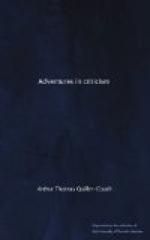And the conclusion is that if Mrs. Woods could not conquer the difficulties which beset any attempt to make protagonists of two historical characters, if she was obliged to follow the facts to the detriment of composition, she has vitalized and recreated a dead age in a fashion to make us all wonder. Esther Vanhomrigh is a great feat, and its authoress is one of the few of whom almost anything may be expected.
* * * * *
Jan. 26, 1895. “The Vagabonds.”
In her latest book,[A] Mrs. Woods returns to that class of life—so far as life may be classified—which she handled so memorably in A Village Tragedy. There are differences, though. As the titles indicate, the life in the earlier story was stationary: in the latter it is nomadic—the characters are artistes in a travelling show. This at once suggests comparison with M. Edmond de Goncourt’s Les Freres Zemganno; or rather a contrast: for the two stories, conceived in very similar surroundings, differ in at least two vital respects.
Compared with “Les Freres Zemganno.”
For what, in short, is the story of Les Freres Zemganno? Two brothers, Gianni and Nello, tumblers in a show that travels round the village fairs and small country towns of France, are seized with an ambition to excel in their calling. They make their way to England, where they spend some years clowning in various circuses. Then they return to make their debut in Paris. Gianni has invented at length a trick act, a feat that will make the brothers famous. They are performing it for the first time in public, when a circus girl, who has a spite against Nello, causes him to fall and break both his legs. He can perform no more: and henceforward, as he watches his brother performing, a strange jealousy awakes and grows in him, causing him agony whenever Gianni touches a trapeze. Gianni discovers this and renounces his art.
Now here in the first place it is to be noted that the whole story depends upon the circus profession, and the brothers’ love for it and desire to excel in it. The catastrophe; Nello’s jealousy; Gianni’s self-sacrifice; are inseparable from the atmosphere of the book. The catastrophe is a professional catastrophe; the jealousy a professional jealousy; the sacrifice a sacrifice of a profession. And in the second place we know, even if we had not his own word for it, that M. de Goncourt—contrary to his habit—deliberately etherealized the




